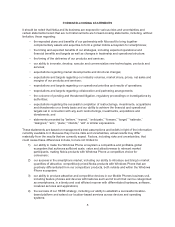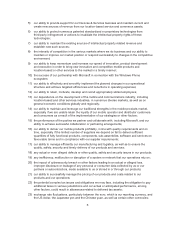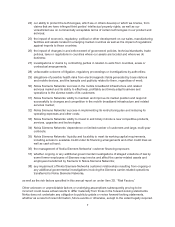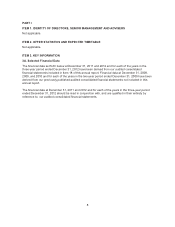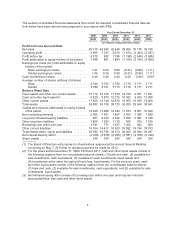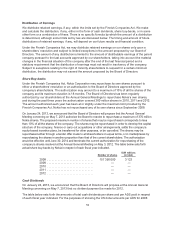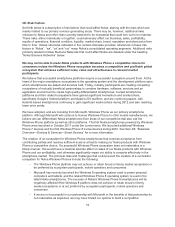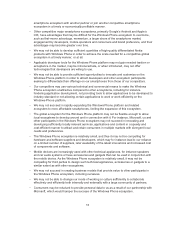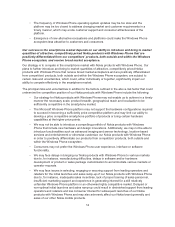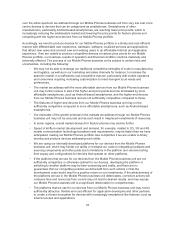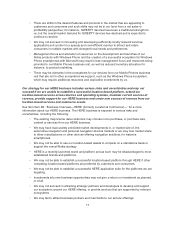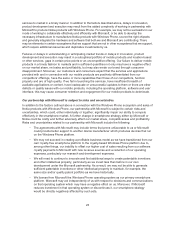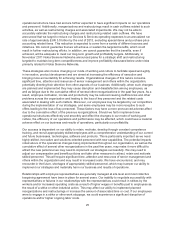Nokia 2012 Annual Report Download - page 16
Download and view the complete annual report
Please find page 16 of the 2012 Nokia annual report below. You can navigate through the pages in the report by either clicking on the pages listed below, or by using the keyword search tool below to find specific information within the annual report.• We may not succeed in creating a high level of consumer interest for our Nokia products with
Windows Phone, in converting interest for our Nokia products with Windows Phone to
purchase decisions or in making the Nokia brand more desirable than brands of our
competitors in smartphones.
• Microsoft may not be able to provide the software innovations and features we rely on for the
Windows Phone operating system in a timely manner, if at all. Additionally, we are dependent
on Microsoft for timely error corrections for customer and country variants as well as generic
software releases.
• Our competitors may provide incentives to operators, retailers or developers that may make it
unattractive for them to support Nokia products with Windows Phone, or our competitors may
use various technical and commercial means to make it unattractive for consumers that
currently use another product to purchase Nokia products with Windows Phone, including for
instance hindering application development, not providing tools to allow applications to be
developed to industry standards or not allowing certain applications to work or work efficiently
on the Windows Phone platform.
• In choosing to adopt Windows Phone as our primary smartphone platform, we may forgo
more competitive alternatives achieving greater and faster acceptance in the smartphone
market. If the benefits of the Microsoft partnership do not materialize as expected, more
competitive alternatives may not be available to us in a timely manner, or at all.
• Other manufacturers also produce competing mobile products which are based on the Windows
Phone operating system. We may face increased competition from other manufacturers,
including Microsoft, who already produce or may produce competing Windows Phone based
products. Increased competition within the Windows Phone ecosystem could result for instance
in lower sales of our devices or lower potential for a profitable business model.
• Our strategy for Nokia products with Windows Phone may erode our brand identity in markets
where we are traditionally strong and may not enhance our brand identity in markets where
we are weak. For example, our association with the Microsoft brand may not accelerate our
access to a broader market in the United States.
• We are aiming to expand our Windows Phone-based products to lower price points. The
availability of Windows Phone-based products that we or our competitors offer at lower price
points may have a negative effect on the sales of our higher priced Windows Phone-based
products.
We may not be able to produce attractive and competitive devices in our Mobile Phones
business unit, including feature phones and devices with features such as full touch that can
be categorized as smartphones, in a timely and cost efficient manner with differentiated
hardware, software, localized services and applications.
The feature phone market, also referred to as the mobile phone market and a traditional area of strength
for us, is undergoing significant changes. Today, a feature phone-specific ecosystem has emerged
involving very low-cost components and manufacturing processes. Speed to market and attractive pricing
are critical factors for success in affordable devices. In particular, the availability of complete mobile
solutions chipsets and software from low-cost reference design chipset manufacturers has enabled the
very rapid and low-cost production of feature phones, increasingly at lower price points, by numerous
manufacturers particularly in China and India, which are gaining significant market share in emerging
markets, as well as bringing some locally relevant innovations to the market.
Many mid-range to high-end feature phones increasingly offer access to the Internet and applications
and provide more smartphone-like features and design, blurring the distinction between smartphones
and feature phones and can be categorized as smartphones. We are subject to intense competition
15


